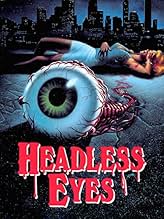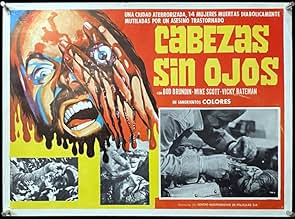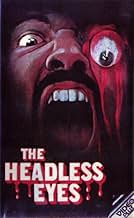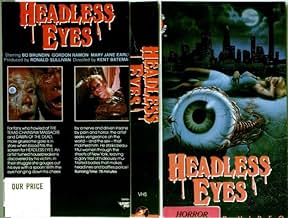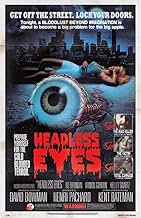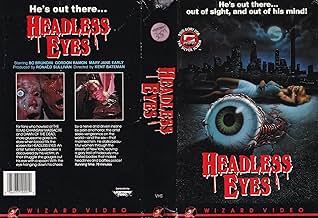Füge eine Handlung in deiner Sprache hinzuPoor artist gets eye gouged out while committing a robbery. When his eye heals, he goes on a killing spree and cuts out women's eyes with a spoon.Poor artist gets eye gouged out while committing a robbery. When his eye heals, he goes on a killing spree and cuts out women's eyes with a spoon.Poor artist gets eye gouged out while committing a robbery. When his eye heals, he goes on a killing spree and cuts out women's eyes with a spoon.
Mildred Hinkley
- Old lady
- (Nicht genannt)
Larry Hunter
- Harry Silver
- (Nicht genannt)
Mary Lamay
- Mrs. Silver
- (Nicht genannt)
Linda Southern
- Blonde Prostitute
- (Nicht genannt)
Empfohlene Bewertungen
Long ago(the mid eighties, before it became chic to diss bad movies and glorify their ineptitude), I caught this freaky flick the way nature intended, on a late-night horror show on an independent TV station. Even then, before the advent of our culture of irony, I knew I'd seen something so unrelentingly bad that it was remarkable. This movie concerns an artist who, while attempting to rob a sleeping woman to get rent money, has one eye put out by his victim. Driven insane, he goes about the unnamed city where he lives(New York), encountering various people, killing them, then attaching their eyeballs to mobiles and suspending them in blocks of acrylic. The victims include a boozy, bickering middle aged couple, a prostitute, and a middle-aged receptionist in an office building. The film has very little in the way of a narrative structure; our mad artist basically drifts around in a stupor, encountering people and killing them. This may be part of the director's masterplan; this mess apparently was some attempt to make a statement about the isolation of urban living. Viewers are treated to a bizarre dream sequence in which the artist staggers deliriously down canyon-like city streets barefoot and ragged, stopping to bang his fists against what appear to be the tall wooden doors of a church. Holy Fellini on Ripple! There's also a documentary-like sequence in which the landlady of one of the killer's victims is interviewed by a reporter and spouts bland, insincere compliments about a young woman she probably never spoke to("She was a nice girl, never any trouble," etc.)The entire film has a hollow, detached feel to it, something that can't entirely be blamed on the filmmakers' incompetence. Or maybe I'm just an optimist. Make no mistake, it is bad--crummy sound and cinematography, stilted dialogue(when available), superflous characters(the artist's wealthy former girlfriend, a young art student who wants to take lessons)who must have been inserted to give friends of the director parts, and artsy sequences that were intended to show the filmmaker's vision but only showcase his lack of ability. And this flick was on video at one point, but is undoubtably out of print now. If you have any independently owned video shops in your area and don't mind slumming(you know, the kind that have a back stock of wretchedly bad old videos), look for this one. Rent it, get some of your hipper-than-thou friends together, and inact your own episode of Mystery Science Theatre!
Whoa! This low-budget experiment in horror was directed by me, Kent Bateman, and with few funds, we did the best we could. Obviously, it wasn't fitted with enough blood and gore for the distributor, so the producer, Ron Sullivan, added some scenes. I only wish to make a comment on the assertion of a reviewer who erroneously referred to me, Kent Bateman, as aka Henri Pachard. Mr. Ron Sullivan, the producer of the film, aka Henri Pachard, producer of over 300 porno films, took my director's cut and added footage I never wrote or directed. This is just to set the record straight. Kent Bateman is not HENRI PACHARD. Please refer to my own IMDb listing. If you go to Henri Pachard's IMDb listing, you will see that he doesn't even list Headless Eyes as one of his films.
"The Headless Eyes" follows a struggling New York artist who loses his eye in a botched robbery attempt; consequently, he develops a bizarre obsession with eyeballs, and goes on a brutal murder spree, killing women and tearing out their eyes with spoons.
Written and directed Kent Bateman, "The Headless Eyes" is a gritty and gruesome exploitation flick that was an ostensible inspiration on later New York-based films like "The Driller Killer" and "Maniac"; it's two parts grindhouse filth and one part art-house horror. The film features an over-the-top performance by Swedish actor Bo Brundin, who leads a very small cast through a scuzzy New York City just after the dawn of the 1970s. It's an interesting film merely as a time capsule, and also functions as a dark meditation on poverty and hopelessness.
The film boasts a handful of surprisingly savage murder scenes and expected eye gougings; in spite of some hammy special effects, the scenes retain a disturbing grit to them that is unexpectedly palpable and disturbing. The narrative is relatively aimless and frenetic; there is little in the way of plot, and the film does feel something like a stitched-together patchwork of gore and half-baked ideas; that said, the messiness gives the film a somewhat disconcerting, schizophrenic energy, and the relative lack of dialogue is another unusual feature. The ending is abrupt and uneven, but it's difficult to expect anything else.
Overall, "The Headless Eyes" is a fairly gruesome but aimless exploitation effort. The skeletal plot and hammy performances don't necessarily work in its favor, but it does retain a bizarre and disturbed energy that makes it worth a watch for die-hard grindhouse horror fans. It's certainly not a good film, but it is tonally scuzzy and forbidding. It's the kind of film that triggers the urge to take a hot bath after viewing, which, depending on your proclivities, will either elicit interest or turn you away. 6/10.
Written and directed Kent Bateman, "The Headless Eyes" is a gritty and gruesome exploitation flick that was an ostensible inspiration on later New York-based films like "The Driller Killer" and "Maniac"; it's two parts grindhouse filth and one part art-house horror. The film features an over-the-top performance by Swedish actor Bo Brundin, who leads a very small cast through a scuzzy New York City just after the dawn of the 1970s. It's an interesting film merely as a time capsule, and also functions as a dark meditation on poverty and hopelessness.
The film boasts a handful of surprisingly savage murder scenes and expected eye gougings; in spite of some hammy special effects, the scenes retain a disturbing grit to them that is unexpectedly palpable and disturbing. The narrative is relatively aimless and frenetic; there is little in the way of plot, and the film does feel something like a stitched-together patchwork of gore and half-baked ideas; that said, the messiness gives the film a somewhat disconcerting, schizophrenic energy, and the relative lack of dialogue is another unusual feature. The ending is abrupt and uneven, but it's difficult to expect anything else.
Overall, "The Headless Eyes" is a fairly gruesome but aimless exploitation effort. The skeletal plot and hammy performances don't necessarily work in its favor, but it does retain a bizarre and disturbed energy that makes it worth a watch for die-hard grindhouse horror fans. It's certainly not a good film, but it is tonally scuzzy and forbidding. It's the kind of film that triggers the urge to take a hot bath after viewing, which, depending on your proclivities, will either elicit interest or turn you away. 6/10.
Basement grindhouse fare, not as gory as it's reputed featuring an unhinged performance by Bo Brundin as the tortured artist who loses an eye, but discovers a new art form.
Frustrated artists always seem to be fodder for film psychopathy, and 'The Headless Eyes' continues that trend in earnest, assisted by a compelling title no doubt responsible for much of its appeal (that and as other reviewers have remarked, the graphic VHS cover art).
Gritty-looking guerilla-style location photography and some almost avant garde touches in Kent Bateman's directorial debut shows potential, but the novel plot device disappointingly never evolves into more than a just a few random stalk & slash encounters. I'd hoped the art student sub-plot late in the picture might resurrect things, but it looks like the $$$ may have evaporated and instead the film ends quite abruptly.
The incessant shrieking of 'my eye!' will live-on in your consciousness well beyond the meagre 70 mins runtime, an enduring accomplishment few films achieve, but unless you're a devotee of no-budget 70's slashers, I think you could feel underwhelmed by 'The Headless Eyes'.
Frustrated artists always seem to be fodder for film psychopathy, and 'The Headless Eyes' continues that trend in earnest, assisted by a compelling title no doubt responsible for much of its appeal (that and as other reviewers have remarked, the graphic VHS cover art).
Gritty-looking guerilla-style location photography and some almost avant garde touches in Kent Bateman's directorial debut shows potential, but the novel plot device disappointingly never evolves into more than a just a few random stalk & slash encounters. I'd hoped the art student sub-plot late in the picture might resurrect things, but it looks like the $$$ may have evaporated and instead the film ends quite abruptly.
The incessant shrieking of 'my eye!' will live-on in your consciousness well beyond the meagre 70 mins runtime, an enduring accomplishment few films achieve, but unless you're a devotee of no-budget 70's slashers, I think you could feel underwhelmed by 'The Headless Eyes'.
There's a lot to be said about this grisly extreme low budget thing, much of it not too good so far, however it is a precursor to the Henenlotter style, not a copy of such, as was implied by another commenter. It's not hard to imagine that Henenlotter, Abel Ferrara and maybe even Scorcese caught this at a midnight screening or something when they were younger. If viewed being mindful of its year of production (released 1973 but production started around 1970-71), it comes on the heels of the angst-ridden French New Wave and borrows much from that style. Every independent film "artist" was familiar with the French New Wave, especially New Yorked based ones
There are actually moments that are quite unnerving watching this eye-stealing serial killer move in and out of a psychosis and stalk his prey. Not as nicely done as Michael Lerner's eye-obsessed maniac in ANGUISH, but still effective. It's hinted that he may have two personalities, but it really seems more like schizophrenia. (No, they are not the same thing!) The gore effects are poor to adequate for the time and budget, they would be considered lame by modern standards. As typical for horror films of this period, it's reflective of the bloodshed and violence of Vietnam that was consistently broadcast over television, and of the dread regarding the effects of the war on returning veterans. This is a common theme, that has become more visible as time passes, in horror and other films of violence of the time
While the main character, the killer, has nothing to do with the war, the mental anguish and violence are sure themes of this period. You won't like this much if you must have super-realistic gore effects and hyper-intense action with cardboard characters, but for those horror fans who lived through this period and those who are interested in studying the horror films of the time, this one is worth the few dollars you can buy it for on VHS on Amazon, less than what it costs on ebay, where it's available on bootleg DVDs. With a wonderfully eerie soundtrack as well and a nicely done understated ending. Nice to view on a double-feature with THE SEVERED ARM.
There are actually moments that are quite unnerving watching this eye-stealing serial killer move in and out of a psychosis and stalk his prey. Not as nicely done as Michael Lerner's eye-obsessed maniac in ANGUISH, but still effective. It's hinted that he may have two personalities, but it really seems more like schizophrenia. (No, they are not the same thing!) The gore effects are poor to adequate for the time and budget, they would be considered lame by modern standards. As typical for horror films of this period, it's reflective of the bloodshed and violence of Vietnam that was consistently broadcast over television, and of the dread regarding the effects of the war on returning veterans. This is a common theme, that has become more visible as time passes, in horror and other films of violence of the time
While the main character, the killer, has nothing to do with the war, the mental anguish and violence are sure themes of this period. You won't like this much if you must have super-realistic gore effects and hyper-intense action with cardboard characters, but for those horror fans who lived through this period and those who are interested in studying the horror films of the time, this one is worth the few dollars you can buy it for on VHS on Amazon, less than what it costs on ebay, where it's available on bootleg DVDs. With a wonderfully eerie soundtrack as well and a nicely done understated ending. Nice to view on a double-feature with THE SEVERED ARM.
Wusstest du schon
- WissenswertesLarge portions of the soundtrack are taken from the LPs "TVMUSIC 101" (France 1969) and "TVMusic 102" (France, 1970) by Cecil Leuter (aka Roger Roger) and Georges Teperino.
- Alternative VersionenThe Blu Ray released by Code Red omits the title card
- VerbindungenFeatured in Video Nasties: Draconian Days (2014)
Top-Auswahl
Melde dich zum Bewerten an und greife auf die Watchlist für personalisierte Empfehlungen zu.
- How long is The Headless Eyes?Powered by Alexa
Details
Zu dieser Seite beitragen
Bearbeitung vorschlagen oder fehlenden Inhalt hinzufügen

Oberste Lücke
By what name was The Headless Eyes (1971) officially released in India in English?
Antwort
